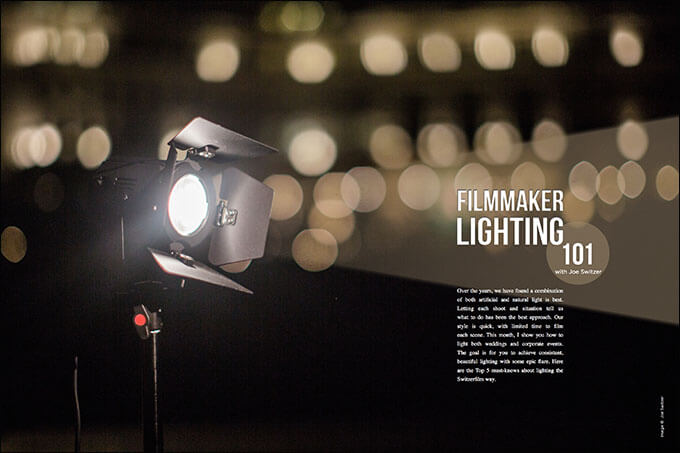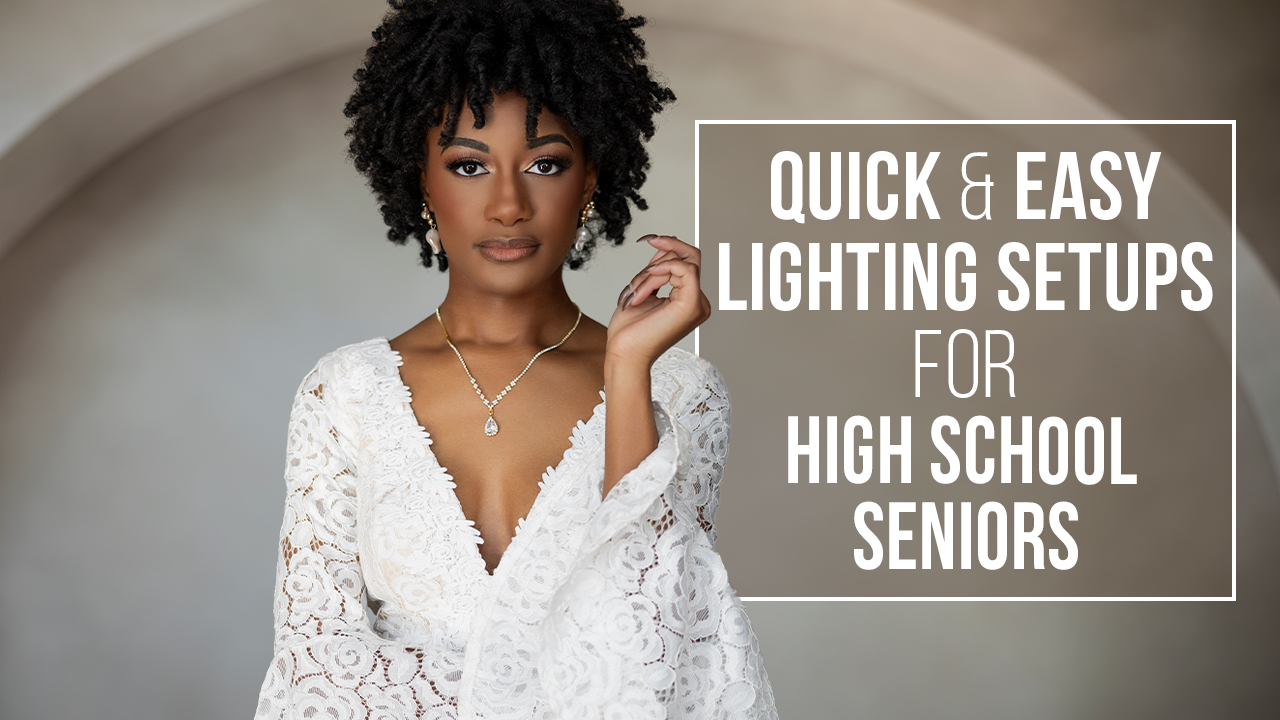Filmmaker Lighting 101 with Joe Switzer
Over the years, we have found a combination of both artificial and natural light is best. Letting each shoot and situation tell us what to do has been the best approach. Our style is quick, with limited time to film each scene. This month, I show you how to light both weddings and corporate event. The goal is for you to achieve consistent, beautiful lighting with some epic flare. Here are the Top 5 must-knows about lighting the Switzerfilm way.
#5 – Working with different lighting temperatures in the same room
If you film or photograph weddings, this is something you’ll run into consistently. On a typical wedding day, when you walk into the bridal suite, there can be three or four different-colored lights in the room—lights on the ceiling, lights on the walls, some window light and a bulb light from the makeup artist blasting on the face of the bride.
When we were first getting started, we would just film and hope we could change the color in post. That approach didn’t work. The color of our videos was inconsistent and unflattering. To avoid trying to match up all the different lights, we have learned to always move our subject. In almost 100 percent of all situations, there is always a window with some natural light.
We arrive early and work with the makeup artists to help them bring their equipment to the light. More often than not, the hair and makeup professionals are happy to work with us. After we get our main subject near the window light, we turn off all other lights. This allows us to keep our subjects bright and the background darker. Natural light looks beautiful, and you don’t have to mess with any artificial lights in tight spaces.
Avoid filming with different lights on in a room. Find a way to get to the natural light and turn all the other lights off when you can. If the hair and makeup artists need a light on, it’s okay to have one light on for the rest of the room to keep everyone happy, but less is best in these situations. A good rule of thumb is to take the bride to a window and turn off all the lights. In extreme situations, we have changed rooms or moved the bride or groom to the hotel lobby. Take action and get rid of all the mixed lighting.
#4 – Wedding reception light
What do you do when the DJ turns on his blue, green and red lights? You could do nothing, and have a bride with a red or blue face for all the reception video shots. That’s not an option. You could ask the DJ to turn off his lights. That’s not going to happen without a fight. Adjusting the settings in your camera for five or 10 minutes that you don’t have won’t help much.
Receptions are dark, so you have no natural light to work with. The only solution in these situations is to have your own lights ready to go. We’ve tried a half dozen different lights. Our vision for artificial lighting was something small and powerful. This wasn’t really possible until LED lighting technology became available.
For 100 percent of all our artificial light solutions, we use Fiilex lights. The model we use is the S282 Mini All-Weather Interview Kit. This light is portable, bright, water-resistant and small. We can quickly adjust color temperatures and change the brightness. Our photographers are ecstatic when we turn on these lights. The lights have a barn door, so we can control the size of the light. This works wonderfully for dances and speeches because the reception venue theme and look remain the same and the subject is in beautiful light.
The next time a DJ uses his rainbow lights on the dance floor, you won’t have to worry if you have the Fiilex light setup. Your light will overpower his, and you’ll have the consistent beautiful light you want. For our shoots, we carry two lights and stands with a set of extra batteries. We want to be portable and never worry about plugging into an outlet. If the reception is outside on a beach and it’s raining, the Fiilex lights are weather-resistant and the batteries last for hours. No more struggles with wedding reception lighting. Make it easy on yourself and go get a Fiilex S282 kit.
#3 – Lighting etiquette
It’s likely you’ve worked with a photographer or filmmaker who had no clue about what’s right or wrong at a wedding reception or other event. Remember that planners, designers and coordinators have worked a year or more on these events. They have themes, colors and details that are important to your client. Those clients have spent the majority of their budget on that, not your video services. You could be ruining the ambiance of the party with your oversize video lights if you’re not careful.
This is not always about what you want or need. It’s about the team you’re working with and the client. Take a step back and realize that what you shine at the reception can do damage if it’s too much. Keeping lighting to a minimum has worked well for us. For the major events like first dance or a speech, we crank the brightness higher. When nothing is happening, we turn the lights off.
Put the lights in a low-traffic place so people don’t notice or trip on your expensive gear. The ultimate goal is to not ruin the mood of the room or moments with your dorky video light. Good common light etiquette goes a long way, and you’ll get referrals from planners, DJ’s and other photographers when you show your team-player attitude.
#2 – Looking for the light
I’m always looking for light in every scene. My first step is to look at the ground and then factor in the sky. Ultimately, your camera will show you what looks good. Over time, you’ll get more comfortable finding light more quickly. When I’m looking for the perfect light positioning, I use edges of lights that a building might cast in a city. In a park, a shade tree gives a beautiful light flare when shooting a subject in motion. If I’m shooting into the light, it’s a given that a Ronin-M or track should be used.
The look of sun flare and motion look epic. Have your camera set to manual so you can control the exposure. If you’re filming into the sun on AV or auto mode, it will change the exposure and take away your sun flare. On just about every video shoot, we walk on set and ask, “Where do you want us?” Before you answer that question, let the light tell you what to do.
For close-ups of people, I look for shade so they’re not squinting. The same can be said for interviews. When we’re filming adventure or action, we want all the sun flare we can get. It’s easy to forget about background lighting like bokeh, which is the out-of-focus background light. The lens and background you choose determine how your bokeh looks.
One of our favorite lenses for this is the 85mm, but as long as you have a long lens or a lens with a lower aperture option, you’ll be able to maximize bokeh. The most typical example of good bokeh is candlelight. On our recent shoot inside a spa, we were able to position the subject where the background had all the candlelight, which maximized the bokeh.
Always be thinking about how to maximize your natural light and background light to get the results you’re looking for.
#1 – Controlling the schedule
We always try to schedule our filmmaking around the “magic light” times. That means early or late in the evening.
A good example of this is the workflow and scheduling of our most recent photo and video shoot in Pennsylvania. During the heat of the day, we filmed inside or in shade. Most of the shots were outside hotels, in spas and by pools, on golf courses and beauty shots. For lighting to look dreamy outside, it’s crucial to get your scheduled shoots during the first two hours in the morning and the last two hours of sunlight in the evening.
Mornings worked well for golfing because the grass sparkled with dew in the rising sun. It has a glistening effect, and looks incredible in wide shots. Sometimes you get those puffy white clouds and sunshine that can look great at high noon. Always work with your client to get the most of your weather and natural light conditions.
Design the schedule in your favor. When you run into rain or extreme weather conditions, you can go to your backup plan for inside or under cover. Don’t let your corporate clients or wedding couples determine the schedule. Plan for lighting success with a good game plan to take advantage of weather, sunrises and sunsets.
On your next shoot, don’t settle for average lighting. Move your subjects, turn lights off, have your artificial mobile lights charged and ready. Take control of the schedule and look for those shadows and sun flare. Move quickly, and remember: No matter what situation you face, you can always find good light.




